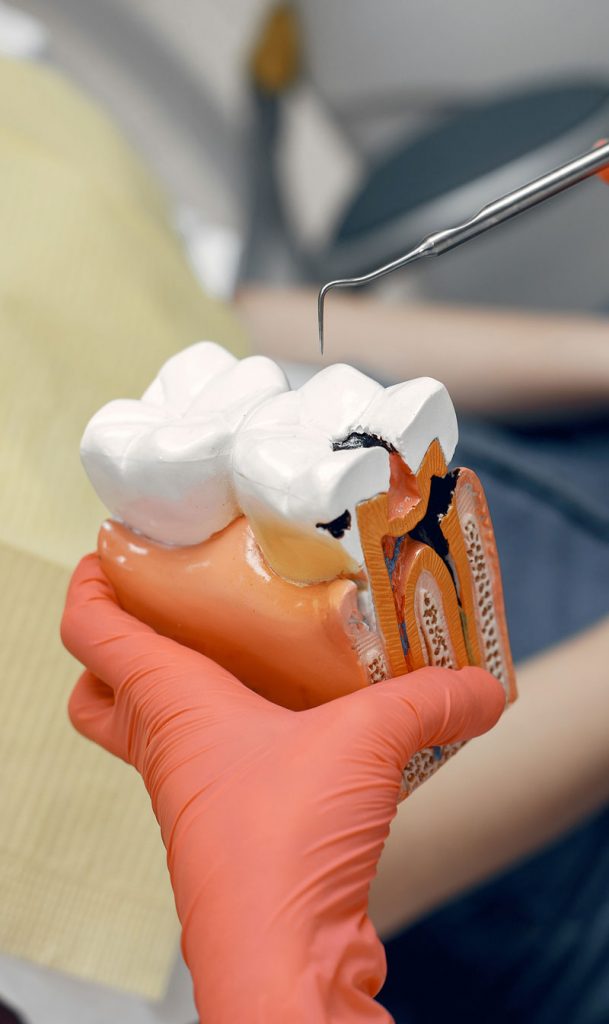
Temporary filling emergency appointment
If you have had a dental treatment and the dentist placed a temporary filling that has become chipped or fallen off, your tooth is exposed to bacteria which can cause plenty of damage. Book an emergency appointment at one of our 4 centrally located dental clinics to have your filling replaced.

What is a temporary filling?
Tooth decay or cavities can result from frequent consumption of high sugar-containing food products, sugary liquids and improper brushing and flossing habits. This leads to bacterial plaque accumulation on the surfaces of the teeth. These bacteria release toxins and damage the tooth structure leading to visible cavities or holes in the tooth, brownish-black stains, tooth sensitivity and throbbing pain.
Our highly skilled dentists in London remove the infected tooth portion and use dental cement or tooth-coloured composite resins to replace the lost tooth structure and restore its shape, size, height and appearance to prevent further decay. Dental fillings are generally permanent; however, in certain cases, our dentist may initially treat the decayed, infected tooth with a temporary one.
As the name suggests, a temporary filling is a brief dental treatment to restore a damaged tooth. They restore the tooth to its standard function, alleviate the sensitivity and pain associated with dental decay. These fillings are not meant to last; they are a semi-permanent fix and have to replaced by permanent fillings, which will be done during a scheduled follow-up appointment.
When is a temporary filling needed?
Our dentists may use a temporary alternative to a white filling in the following conditions.
- If you have severe pain and sensitivity, a temporary filling is given first. These fillings contain medicaments that soothe the nerves of the tooth and allow the tooth to heal. At a later appointment, our dentist will examine the tooth to ensure that it has healed, the pain has gone away, and when no further intervention is required, they will place a permanent filling.
- In cases where you have been prescribed with an inlay or an onlay. Inlays and Onlays are custom made for each patient in the lab and require time. In such cases, our dentists may place a temporary filling in the interim to protect and restore the damaged tooth.
- In some cases, where the progression of dental decay cannot be determined, a temporary filling is placed. If the pain still persists, our dentist will perform a root canal procedure. However, if the pain subsides, and there is no need for a root canal treatment, our dentist will replace it with the permanent filling using dental cement or composite resins.
- Root canal procedure requires multiple spaced visits. Our dentists in London will place a temporary filling to seal the hole in the tooth. This prevents any more bacteria and food debris from entering the tooth and causing further complications.
Temporary fillings are also used to protect the teeth until the dental crown is ready. The filling protects the tooth from further damage and restores some function.

How to take care of your filling?
Temporary fillings are not as durable as permanent fillings and can come out easily. You must take specific measures and precautions to keep yours in place. After you receive an acting dressing at our clinic in London, your dentist will give you particular instructions which you must follow to make sure the filling lasts until your next appointment with us.
- Our dentist may advise you to not eat or drink for some time (an hour or two) after the appointment to allow it to harden.
- Once it hardens, you still have to be careful of what you eat. Try not to chew from the side of your mouth, which has a filling.
- In many cases, our dentist will instruct you to avoid chewing using the side of your mouth, which has a temporary filling for 24 hours.
- Avoid hard and sticky food substances like candies, chewing gums or nuts when you have a temporary filling. Instead, opt for soft foods, especially if you have a filling on both sides of your mouth
- Take care when brushing and flossing. Use a soft-bristled toothbrush and use a gentle motion while cleaning the tooth with the temporary filling.
- Do not try to force a floss if your filling is extended. Instead, pull it out gently to avoid dislodging the filling.
- If you experience any pain or sensation while having a temporary filling, call us at our clinic in London and schedule an appointment.
- Lastly, maintain good oral hygiene and prevent any food from getting stuck to your temporary filling.

What to know about temporary fillings?
Materials used for a temporary filling
- Zinc oxide eugenol
- Zinc phosphate
- Glass ionomer cement
- Calcium hydroxide
Temporary fillings do not have the strength and the hardness of a regular permanent dental filling, which means they can fracture and break easily. They can come out even under the slightest pressure; that is why it is important to avoid sticky and hard food substances. Temporary filling wears off with time and can be damaged easily. Damaged and worn off, these fillings give the bacteria the chance to enter the tooth and further damage it.
Therefore, it is essential to replace them with a permanent filling. If your dentist has given you a date for replacement, make sure you keep your appointment to replace the temporary filling as temporary fillings are not meant to last.
